Chicago police are warning residents about a rash of armed carjackings on the city’s near west side. The latest victim is retired Chicago firefighter Lt. Dwain Williams.
Williams was shot while shopping in a local popcorn store when four people approached him and demanded his Jeep Cherokee, ABC 7 reports. One of the suspects shot him in the stomach. The suspects all fled and have not been apprehended.
Williams made it to the hospital but died shortly thereafter. A procession of firefighters and police officers escorted the body of the retired firefighter to the medical examiner’s office. Williams is survived by a wife and four children.
“To give yourself, to give so much of yourself for so long for people you don’t know and for this to be the end result, it sucks, it’s sad,” firefighter Kevin Betton told ABC 7.
Chicago police report carjackings are up by 100 percent in the city this year, ABC 7 reports. There have been at least 1,234 car jackings in Chicago in 2020.
Chicago west side resident Pedro Wade told ABC 7 his neighborhood is extremely dangerous.
“Any conflict at any moment, a small altercation, can end with someone losing their life,” Pedro said.
With a record 700 murders so far this year, Chicago is on track to surpass the city’s previous homicide record. A spike in violence against police officers has accompanied the increased killings. Officers have been shot at 71 times this year, with 10 killed.
“This has been a difficult year for law enforcement throughout the country as COVID-19 and civil unrest have converged to create charged environments in major U.S. cities,” said Chicago police Superintendent David Brown in a statement. “And yet, our officers continue to work hard every day to make our home a safer place. I want to commend our brave officers for putting their lives on the line and working to improve public safety,” Brown said.
The Wall Street Journal reports a 24 percent increase in homicides in the 50 largest states, and Chicago leads the way with more than one of every eight homicides in the nation.
While homicides are increasing, other crimes, such as robbery, are down.
One explanation being offered is “routine activity theory,” which calculates crime as an equation involving the supply of criminals, victims, and potential interference factors of “society’s guardians” such as police, schools, and churches. With the pandemic and associated lockdowns in place across the country, fewer potential victims are out on the street and fewer criminals are willing to break into a home if they believe the homeowner is inside, causing a reduction in robberies and burglaries.
“Homicides, on the other hand, are up because violent criminals have been emboldened by the sidelining of police, courts, schools, churches and an array of other social institutions by the reckoning with police and the pandemic, say analysts and law-enforcement officials in several cities,” writes Jon Hilsenrath for the Journal.
Police report the rise in homicides mostly affects poor neighborhoods, largely black and Latino, around the city centers where anti-police protests have taken place.
In Chicago, most of the killings happen in the south and west sides of the city, “the most disadvantaged neighborhoods that were already suffering the most from longstanding economic challenges and the coronavirus,” Jens Ludwig, a University of Chicago professor and director of its crime lab, told the Journal.
Several other factors are contributing to the rise of violence, Hilsenrath writes. Reduction of bail sends criminals back out into the street. The increase in gang activity is intensified as gang violence begets more gang violence. One attack leads to retribution and further attacks. Gang violence often takes place at large gatherings, and public anger at police, coupled with increasingly tight restrictions on police imposed by progressive politicians, has made it difficult for officers to manage and protect events.
Gang violence has a particularly painful impact on children, as they are often caught in gang crossfire. Dozens of children under the age of 17 have been fatally shot in Chicago this year, often as a result of gang violence, the Chicago Tribune reports.
History shows progressives’ tough-on-police, sympathetic-to-criminals policies result in disaster and misery for much of the public, says Harvard University urban economist Edward Glaeser.
“If the city descends into the level of danger that we saw in the 1970s, that will be a challenge for all of America,” Glaeser told the Journal.
